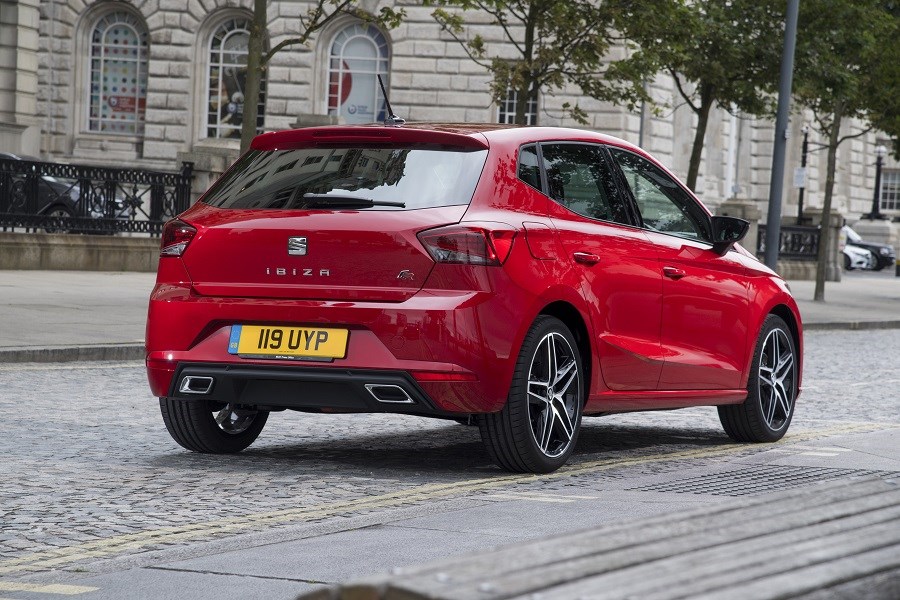Latest model
Seat unveiled the latest fifth-generation Ibiza in January 2017, with sales starting in the summer of the same year. Unlike previous models, this Ibiza was only offered with a five-door variant (as are the latest Volkswagen Polo and Audi A1), while the new model grew in size — being 87mm wider and offering a wheelbase longer by 60mm, although it’s surprisingly 2mm shorter than the model it replaces. This increased wheelbase allowed for a much more practical interior, and a bigger boot, too.
Vast improvements were also made to the safety of the model, while a range of new 1.0-litre petrol engines and a powerful 1.5-litre petrol engine were also offered.
The latest Ibiza was also the first model from the Volkswagen Group to be built on the latest MQB A0 platform, and offered a new and sharper design, with small front and rear overhangs, large alloy wheels and LED lighting.
Since launch, the Ibiza has won a number of awards, including that for ‘Best Supermini’ in the 2018 UK Car of the Year awards. From July 2018, Seat also introduced a new digital cockpit onto the model, which is a customisable 10.25-inch driver display. It adds an extra modern touch to the cabin and aims to relay key information back to the driver. This feature is standard on FR Sport and Xcellence Lux trim levels.
Value for money
Prices for the Ibiza start from £15,495 for the Ibiza, which is a lot of money for a small supermini. However, unlike other models in this class, Seat doesn’t offer the model in the same low-spec trim levels and under-powered engines, which is why the Ibiza takes up a higher price point.
On the plus side, it comes with an excellent amount of standard equipment, including 15-inch alloy wheels, metallic paint, a 6.5-inch touchscreen with Apple CarPlay and Android Auto connectivity and autonomous emergency braking. Top spec models are expensive, though, with FR and Xcellence models easy to spec to over £20,000, which seems expensive for a non-sporty supermini.
The Ibiza has lots of appeal for new drivers and for those looking for a cheap and reliable small car. The most affordable used examples start from as little as £500 for a well-maintained example.
As for the latest model, there are some superb discounts that can be had. At the time of writing, the cheapest fifth-generation car started from £7,500 for a 2017 model with the entry-level engine and trim level, although this still represents excellent value for money. Nearly-new models are also superb on the pocket, with an example less than a year old costing under £10,000 which is thousands off list price. We would recommend spending around £11,000 on the more powerful 94bhp turbocharged petrol engine, though.
Looks and image
The Seat Ibiza has always been a car tailored towards a younger audience, and the latest model’s impressive standard tech furthers this appeal. Seat has also made the Ibiza sharper to look at than ever, but hasn’t been too ambitious with the design. Standard details such as LED daytime running lights and triangular LED rear lights are another nice touch, too. Sporty-looking FR models are the pick of the range where style is concerned, as these come with an FR styling kit, exhaust trim, 17-inch alloy wheels (18s on FR Sport) and LED headlights. They certainly look the part and are as close to a hot hatch as you get within the Ibiza range.
The interior isn’t quite so stylish, although it offers plenty of tech and comfort, which most buyers are looking for. A 6.5-inch touchscreen is fitted as standard to SE models, and offers Bluetooth and Apple CarPlay and Android Auto, which is excellent on an entry-level supermini. SE Technology cars and upwards add a larger eight-inch touchscreen with satellite navigation and voice recognition. The interior quality isn’t up to the standard of the Volkswagen Polo, with a few cheap interior plastics here and there, but overall, it’s a comfortable and easy to live with interior.
The Seat Ibiza is an excellent all-rounder, and offers comfort and refinement traits rarely found in cars of this size. Even on motorways and at higher speeds, the Ibiza feels superbly composed, and it’s comfortable, too, although the larger 17- and 18-inch alloy wheels can make the car a touch unsettled. It also offers accurate steering, even if it doesn’t provide the same level of feedback as the Fiesta. But with an excellent balance between comfort and excitement, the Ibiza is an easy model to recommend.





